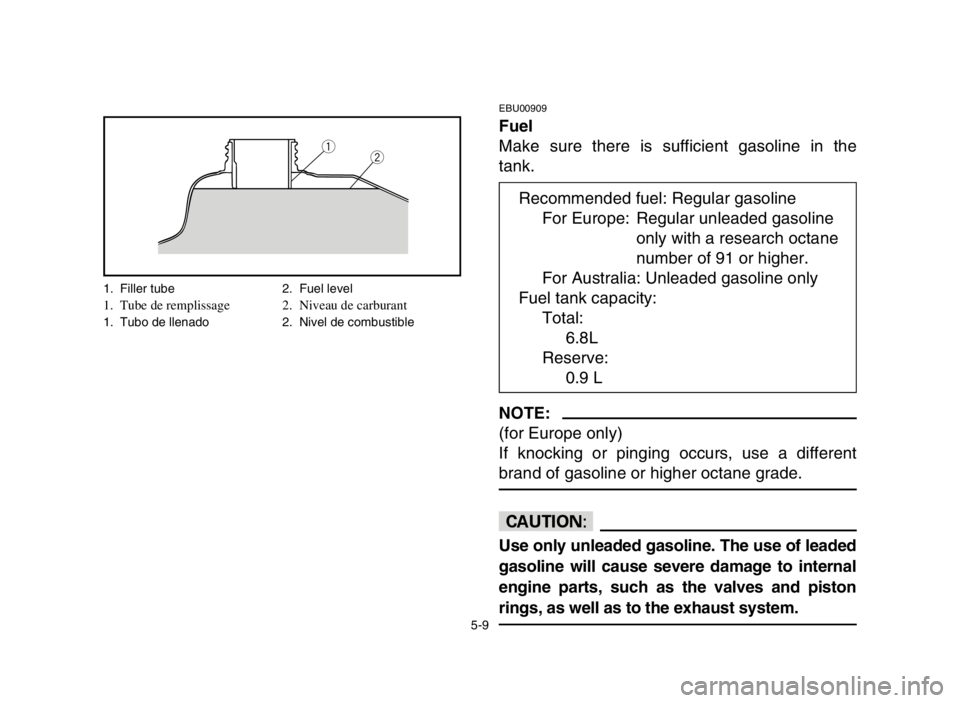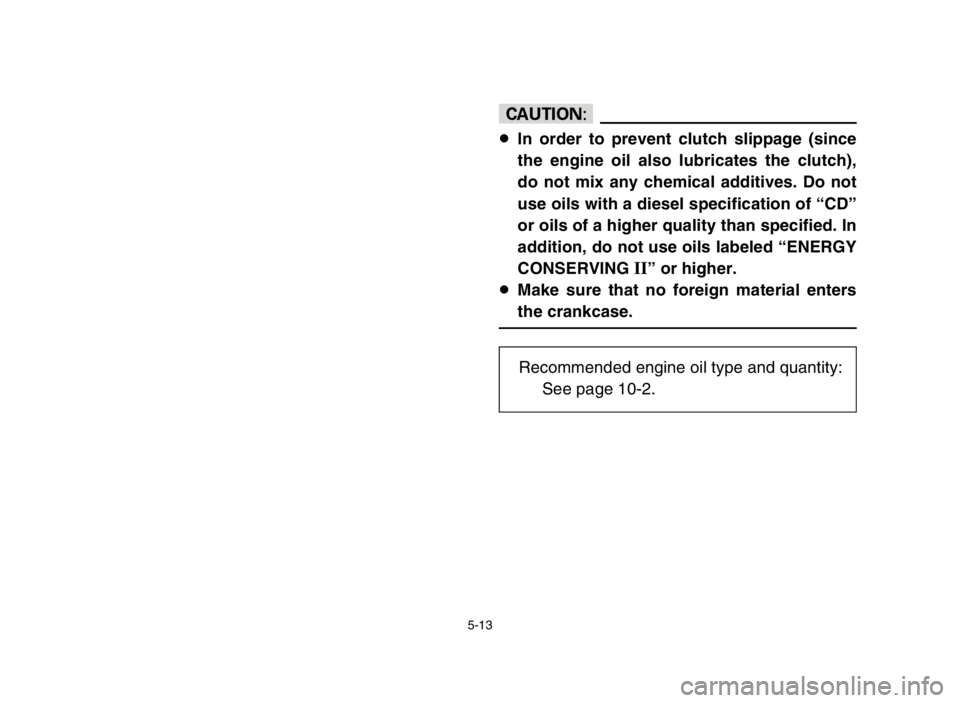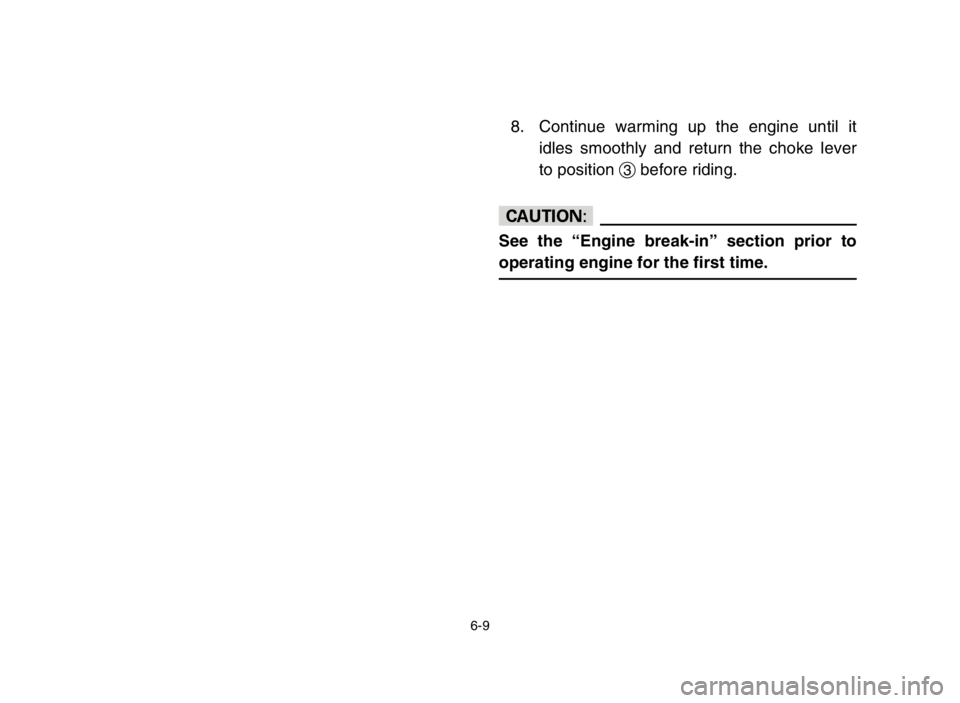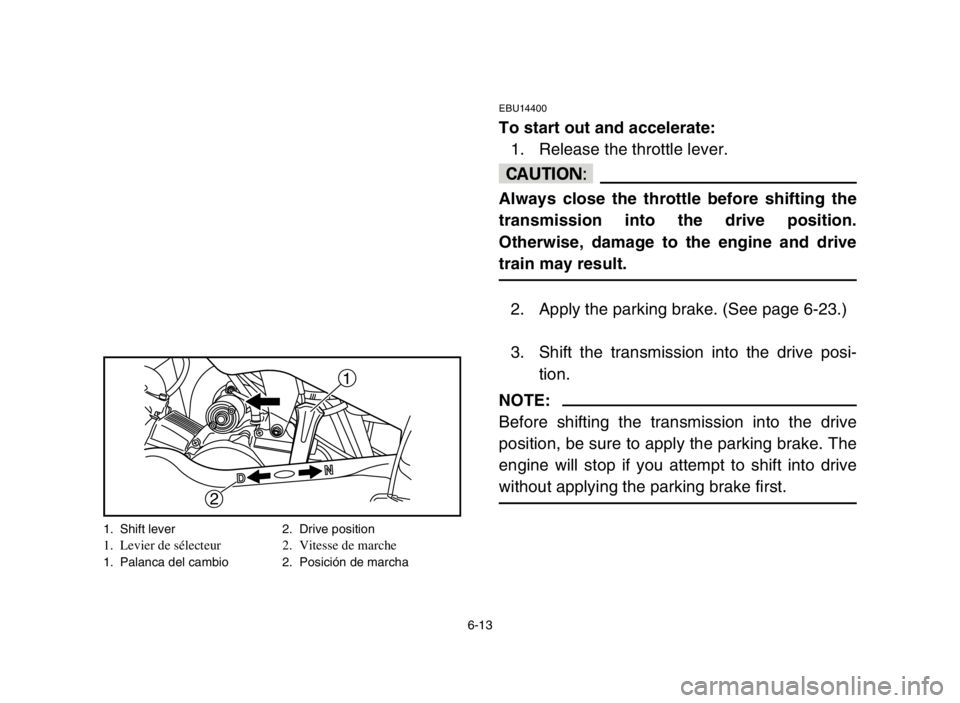engine YAMAHA YFM50S 2004 Owner's Manual
[x] Cancel search | Manufacturer: YAMAHA, Model Year: 2004, Model line: YFM50S, Model: YAMAHA YFM50S 2004Pages: 350, PDF Size: 5.87 MB
Page 106 of 350

5-1
EBU00113
PRE-OPERATION CHECKS
Before using this machine, check the following points:
ITEM ROUTINE PAGE
Brakes9Check operation, condition and free play.
5-5–5-7, 8-41–8-49
9Adjust if necessary.
Fuel9Check fuel level.
9Fill with fuel if necessary.5-9–5-11
Engine oil9Check oil level.
9Fill with oil if necessary.5-11–5-13, 8-13–8-17
Final gear oil9Check for leakage. 5-15, 8-19–8-21
Throttle9Check for proper throttle cable operation. 5-17
Wheels and tires9Check tire pressure, wear and damage. 5-19–5-25, 8-55
Fittings and fasteners9Check all fittings and fasteners. 5-17
Switches9Check operation. 5-17
Battery9Check fluid level.
5-17, 8-57–8-63
9Fill with distilled water if necessary.
5YF-9-60 4~5 4/24/03 7:41 PM Page 28
Page 114 of 350

5-9
EBU00909
Fuel
Make sure there is sufficient gasoline in the
tank.
NOTE:
(for Europe only)
If knocking or pinging occurs, use a different
brand of gasoline or higher octane grade.
cC
Use only unleaded gasoline. The use of leaded
gasoline will cause severe damage to internal
engine parts, such as the valves and piston
rings, as well as to the exhaust system.
Recommended fuel: Regular gasoline
For Europe: Regular unleaded gasoline
only with a research octane
number of 91 or higher.
For Australia: Unleaded gasoline only
Fuel tank capacity:
Total:
6.8L
Reserve:
0.9 L
q
w
1. Filler tube 2. Fuel level1. Tube de remplissage 2. Niveau de carburant1. Tubo de llenado 2. Nivel de combustible
5YF-9-60 4~5 4/24/03 7:41 PM Page 36
Page 116 of 350

5-11
w
8Do not overfill the fuel tank. Fuel expands
when it heats up. If the fuel tank is over-
filled, fuel could spill out due to heat from
the engine or the sun.
8Be careful not to spill fuel, especially on
the engine or exhaust pipe which can
cause a fire and severe injury. Wipe up
any spilled fuel immediately.
8Do not refuel right after the engine has
been running and is still very hot.
8Be sure the fuel tank cap is closed secure-
ly.
EBU10842
Engine oil
Make sure the engine oil is at the specified level.
Add oil as necessary. (See page 8-13.)
5YF-9-60 4~5 4/24/03 7:41 PM Page 38
Page 118 of 350

5-13
cC
8In order to prevent clutch slippage (since
the engine oil also lubricates the clutch),
do not mix any chemical additives. Do not
use oils with a diesel specification of “CD”
or oils of a higher quality than specified. In
addition, do not use oils labeled “ENERGY
CONSERVING
II” or higher.
8Make sure that no foreign material enters
the crankcase.
Recommended engine oil type and quantity:
See page 10-2.
5YF-9-60 4~5 4/24/03 7:41 PM Page 40
Page 134 of 350

6-3
EBU14410
Starting a cold engine
w
Always make sure all control cables work
smoothly before you begin riding in cold
weather. If the control cables are froze or do
not work smoothly, you could be unable to
control the ATV, which could lead to an acci-
dent or collision.
1. Set the parking brake.
2. Turn the fuel cock to “ON”.
3. Turn the main switch to “ON” and the
engine stop switch to “RUN”.
4. Shift the transmission into neutral.
5YF-9-60 6 4/24/03 6:36 PM Page 2
Page 136 of 350

6-5
NOTE:
This model is equipped with an ignition circuit
cut-off system.
The engine can be started under the following
conditions.
a. When the transmission is in neutral. At this
time the neutral indicator light should come
on. If the light does not come on, ask a
Yamaha dealer to inspect it.
b. When the transmission is in the drive posi-
tion and the rear brake lever is applied.
However, it is recommended to shift into
neutral before starting the engine.
5. Use the choke lever in reference to the fig-
ure:
Position 1: Cold engine start–
ambient temperature below 30° C.
Position 2: Warming up position.
Position 3: Cold engine start–
ambient temperature above 25° C
and warm engine start position.
CHOKE
ONOFF
0°10°20°30°
°C
a
3 1
1
23
1. Fully open “ON”2. Half open (warming up position)
3. Closed “OFF”a. Choke lever
1. Pleine course “ON”2. Mi-course (position de chauffe)3. Fermé “OFF”a. Levier de choke
1. Abierto completamente “ON”
2. Semiabierto (posición de calentamiento)
3. Cerrado “OFF”a. Palanca del starter AMBIENT TEMP. / CHOKE LEVER POSITION
POSITION DE LEVIER DE STARTER / TEMP. AMBIANTEPOSICION DEL MANDO DEL STARTER / TEMP. AMBIENTE
5YF-9-60 6 4/24/03 6:36 PM Page 4
Page 138 of 350

6-7
6. Completely close the throttle lever and
start the engine by pushing the start
switch.
NOTE:
If the engine fails to start, release the start
switch, then push it again. Pause a few seconds
before the next attempt. Each cranking should
be as short as possible to preserve battery ener-
gy. Do not crank the engine more than 10 sec-
onds on each attempt.
7. If the engine is started with the starter
(choke) in position 1, the choke lever
should be returned to position 2to warm
up the engine. If the engine is started with
the starter (choke) in position 2, keep the
starter (choke) in this position to warm up
the engine.
5YF-9-60 6 4/24/03 6:36 PM Page 6
Page 140 of 350

6-9
8. Continue warming up the engine until it
idles smoothly and return the choke lever
to position 3before riding.
cC
See the “Engine break-in” section prior to
operating engine for the first time.
5YF-9-60 6 4/24/03 6:36 PM Page 8
Page 142 of 350

6-11
EBU00181
Starting a warm engine
To start a warm engine, refer to the “Starting a
cold engine” section. The choke lever should not
be used. The throttle should be opened slightly.
EBU00184
Warming up
To get maximum engine life, always warm up
the engine before starting off. Never accelerate
hard with a cold engine! To see whether or not
the engine is warm, check if it responds to the
throttle normally with the choke lever turned off.
5YF-9-60 6 4/24/03 6:36 PM Page 10
Page 144 of 350

6-13
1
2
1. Shift lever 2. Drive position1. Levier de sélecteur 2. Vitesse de marche1. Palanca del cambio 2. Posición de marcha
EBU14400
To start out and accelerate:
1. Release the throttle lever.
cC
Always close the throttle before shifting the
transmission into the drive position.
Otherwise, damage to the engine and drive
train may result.
2. Apply the parking brake. (See page 6-23.)
3. Shift the transmission into the drive posi-
tion.
NOTE:
Before shifting the transmission into the drive
position, be sure to apply the parking brake. The
engine will stop if you attempt to shift into drive
without applying the parking brake first.
5YF-9-60 6 4/24/03 6:36 PM Page 12